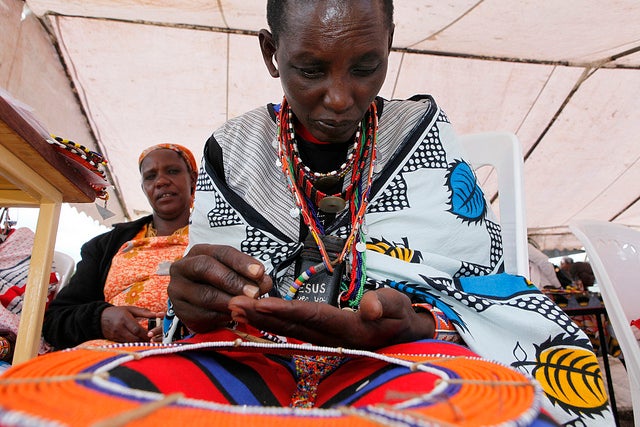In most developed nations, when dealing with the aftermath of a natural catastrophe, an accident, a divorce – or even retirement – women know they can buy and rely on insurance to handle the damages, give them access to long-term savings or, at a minimum, cover a portion of their lost assets.
In emerging and developing markets, on the other hand, this is usually not the case. Working at IFC in Washington and staying in touch with my family at home in Senegal, I’ve heard countless stories of men and women living in terrible conditions after a natural disaster.
These are not only people with lower incomes. I’ve met women who have lost everything following their spouse’s death or divorce because customary practices and inheritance laws did not give them access to the family assets. (In fact, in 20 percent of economies around the world, women do not have the same inheritance rights as men.) Worse, there are women whose children have died because the public hospital was too full and too busy to accommodate them at the time they needed medical help, and because they did not have the means to afford private health care. 
These are sobering and, sadly, true stories that very seldom make headlines. Yet if we look at families’ needs and at how women tend to be more affected by death, disaster and family illness, the answer seems simple: insurance.
It’s only when something bad happens that, all of a sudden, people – especially women, who tend to be more risk-aware – wish that they had planned better to deal with the situation at hand. What tends to keep women from choosing insurance as the solution to their risk-mitigation needs are misperceptions, affordability, lack of awareness, lack of bank accounts or access, and the stories of people with insurance policies that do not seem to cover any claims.
For all these reasons, I was thrilled to work with IFC, AXA Group and Accenture to recently release the report SheforShield: Insure Women to Better Protect All, a first-of-its-kind analysis of how the insurance market can offer stronger coverage for women. Country profiles in the report particularly discuss the opportunities that the women’s insurance market presents in the emerging economies of Brazil, China, Colombia, India, Indonesia, Mexico, Morocco, Nigeria, Thailand and Turkey. Women in these countries face a variety of challenges in finding solutions to their need to address risk.
Based on in-depth interviews with industry representatives, brokers, agents, customers, regulators and insurance associations – combined with economic modelling techniques – the report reveals that, by 2030, the insurance industry is expected to receive up to $1.7 trillion in premium contributions specifically from women. Half of that amount is projected to come from the 10 emerging economies listed above.
The report identifies two main drivers for growth in those 10 markets: first, improvements in women’s socioeconomic conditions, resulting from their increased participation in the workforce and their growing ability to make their own spending decisions; and, second, an increase in women’s willingness to invest in safety, protection and security for their families, dependents and themselves – notably in the form of insurance.
Despite persistent gender wage gaps, women globally earn and own more than ever before: Their incomes are projected to increase globally from $9.8 trillion in 2007 to $15.6 trillion by 2017. Women’s incomes are also expected to grow at a faster rate than men’s. Women are expected to control nearly 75 percent of discretionary spending worldwide by 2028, according to an E&Y report published in 2013. In developing nations, meanwhile, women's earned incomes have been growing at a rate of 8.1 percent annually, compared with 5.8 percent for men, according to Deloitte's Gender Dividend report of 2011 (updated in 2013).
In addition to their growing incomes and increased breadwinning duties, women’s risk-awareness translates directly into a willingness to prioritize expenditures to achieve peace of mind. In researching SheforShield, we found that, across demographic segments in China, Mexico and Nigeria, women indicated that they were willing to spend 10 percent to 20 percent of their incomes to protect against future risks, whereas men would only allocate 7 percent to 10 percent for similar objectives.
Women, particularly working mothers, seek to include their parents, spouses and children in their insurance policies. Insurance companies report that they value women as clients, because women are less likely to inflate insurance claims. They also show stronger loyalty to their insurance providers.
The availability of insurance is not only key for maintaining development progress and for women’s participation in the economic growth of their countries: It is also critical for women’s security and well-being, and that of their children and parents.
Furthermore, as the report shows, insurance companies can benefit by addressing the needs of the women’s market. Insurance firms could reach a new market and differentiate themselves profitably and sustainably, and also have great social impact, by taking into account women’s family roles and financial backgrounds as well as their own needs.
As a daughter, a mother and a wife, I felt that the statements from the women we interviewed while researching SheforShield strongly resonated with me. I find myself lucky, because I am in a situation where I have and can easily acquire insurance. However, would this have been the case if I lived elsewhere, or if I did not work for the World Bank Group?
By addressing the global women’s market for insurance and their own raison d’être, companies can positively affect and improve the stability and progress of developing and emerging countries. What company would not want to play such a role – and why not do something now?


Join the Conversation